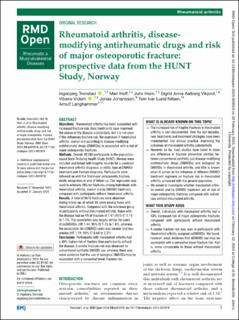| dc.contributor.author | Tronstad, Ingebjørg | |
| dc.contributor.author | Hoff, Mari | |
| dc.contributor.author | Horn, Julie | |
| dc.contributor.author | Vikjord, Sigrid Anna Aalberg | |
| dc.contributor.author | Videm, Vibeke | |
| dc.contributor.author | Johansson, Jonas | |
| dc.contributor.author | Nilsen, Tom Ivar Lund | |
| dc.contributor.author | Langhammer, Arnulf | |
| dc.date.accessioned | 2024-02-26T14:56:19Z | |
| dc.date.available | 2024-02-26T14:56:19Z | |
| dc.date.created | 2024-02-22T14:59:54Z | |
| dc.date.issued | 2023 | |
| dc.identifier.issn | 2056-5933 | |
| dc.identifier.uri | https://hdl.handle.net/11250/3119983 | |
| dc.description.abstract | Objectives Rheumatoid arthritis has been associated with increased fracture risk. New treatments have improved the course of the disease substantially, but it is not clear if this influences fracture risk. We examined if rheumatoid arthritis, overall and according to disease-modifying antirheumatic drugs (DMARDs), is associated with a risk of major osteoporotic fractures.
Methods Overall, 92 285 participants in the population-based Nord-Trndelag Health Study (HUNT), Norway were included and linked with hospital records for a validated rheumatoid arthritis diagnosis (n=605), type of DMARD treatment and fracture diagnosis. Participants were followed up until the first major osteoporotic fracture, death, emigration or end of follow-up. Cox regression was used to estimate HRs for fractures among individuals with rheumatoid arthritis, overall and by DMARD treatment, compared with participants without rheumatoid arthritis.
Results A total of 9670 fractures were observed during follow-up, of which 88 were among those with rheumatoid arthritis. Compared with the reference group of participants without rheumatoid arthritis, those with the disease had an HR of fracture of 1.41 (95% CI 1.13 to 1.74). The association was largely similar for users of csDMARDs (HR 1.44; 95% CI 1.15 to 1.81), whereas the association for bDMARD users was weaker and less precise (HR 1.19; 95% CI 0.64 to 2.21).
Conclusion Participants with rheumatoid arthritis had a 40% higher risk of fracture than participants without the disease. A similar fracture risk was observed for conventional synthetic DMARD use, whereas there was weak evidence that the use of biological DMARDs may be associated with a somewhat lower fracture risk. | en_US |
| dc.language.iso | eng | en_US |
| dc.publisher | BMJ Publishing Group | en_US |
| dc.rights | Navngivelse-Ikkekommersiell 4.0 Internasjonal | * |
| dc.rights.uri | http://creativecommons.org/licenses/by-nc/4.0/deed.no | * |
| dc.title | Rheumatoid arthritis, disease-modifying antirheumatic drugs and risk of major osteoporotic fracture: prospective data from the HUNT Study, Norway | en_US |
| dc.title.alternative | Rheumatoid arthritis, disease-modifying antirheumatic drugs and risk of major osteoporotic fracture: prospective data from the HUNT Study, Norway | en_US |
| dc.type | Peer reviewed | en_US |
| dc.type | Journal article | en_US |
| dc.description.version | publishedVersion | en_US |
| dc.source.journal | RMD Open | en_US |
| dc.identifier.doi | 10.1136/rmdopen-2023-003919 | |
| dc.identifier.cristin | 2248908 | |
| cristin.ispublished | true | |
| cristin.fulltext | original | |
| cristin.qualitycode | 1 | |

